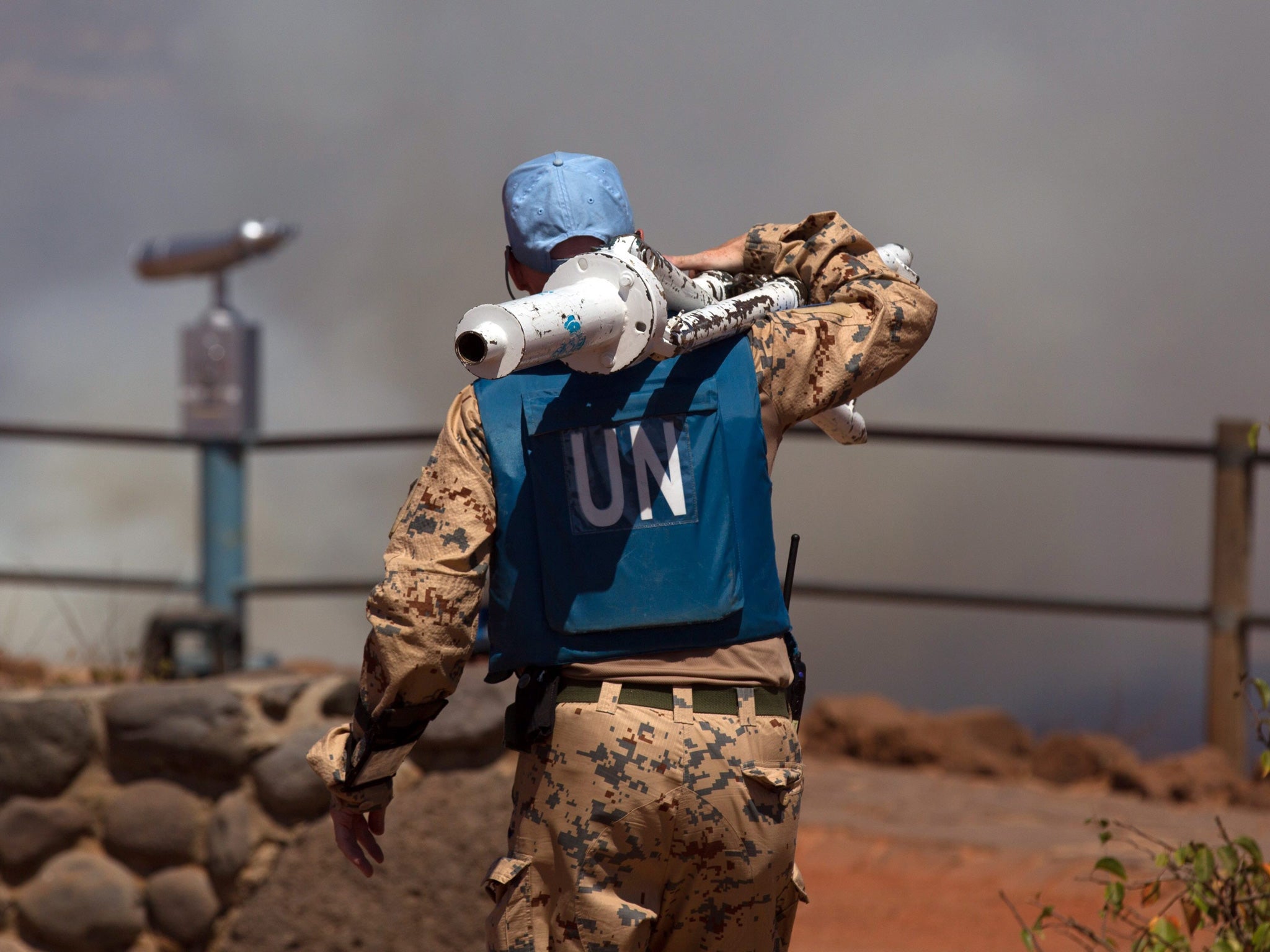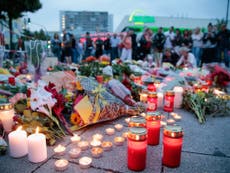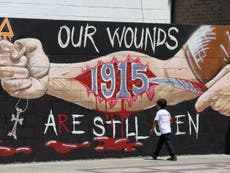It is 10 years since UN peacekeepers were killed in southern Lebanon – and it could happen again now
The Israelis have never revealed their secret. Nor has the present Canadian Government, under the more politically neutral Justin Trudeau, restored the Canadian investigation report to its website


Exactly 10 years ago, four United Nations peacekeepers were blown to pieces in southern Lebanon. They were a Canadian, a Chinese, a Finn and an Austrian. Amid the crash of Israeli shellfire around his tiny concrete blockhouse, and perhaps realising that he may not survive, the Canadian, Major Paeta Hess-von Kruedener, put through a mobile call to his wife Cythia in far-away Ontario It was a bad line.
“Paeta I can’t hear you, there’s static, but I love you, if you can hear me, I love you,” she shouted back down the phone. “Are you all right? I’m going to have to hang up because I want you to call me back because all I can hear is static, but I don’t want to hang up. I love you. I’ve got to hang up.”
Canadian journalist Adam Day would record how von Kruedener’s wife waited with the phone in her hand for her husband to call back – until she turned on the television just before dinner and saw her husband’s face with the caption: “Missing, presumed dead”.
The four men, recording the Hezbollah-Israeli war around them, were killed a few minutes after the Canadian tried to call his wife, just before 7.30 in the evening, when an Israeli F-16 fighter-bomber pilot dropped a GPS-guided 1,000lb bomb directly onto the UN compound. It exploded next to the Finn, Lieutenant Jarno Makinen. By chance, on that day – 25 July 2006 – I was only a few miles from the UN post when it was destroyed.
“To my left, smoke rises too, over the town of Khiam,” I reported in The Independent at the time, “where a smashed United Nations post remains the only memorial to the four UN soldiers – most of them decapitated by an American-made missile on Tuesday – killed by the Israeli air force. Indian soldiers of the UN army in southern Lebanon, visibly moved by the horror of bringing their ... comrades back in ... pieces from the clearly marked UN post next to Khiam prison, left their remains at Marjayoun hospital.”
I knew how close the UN patrol base was to the border. “In past years,” I wrote that night, “I have spent hours with their comrades in this UN position, which is clearly marked in white and blue paint, with the UN’s pale blue flag opposite the Israeli frontier. Their duty was to report on all they saw: the ruthless Hezbollah missile fire out of Khiam and the brutal Israeli response against the civilians of Lebanon. Is this why they had to die, after being targeted by the Israelis for eight hours, their officers pleading to the Israeli Defence Forces that they cease fire?”
The 2006 Hezbollah-Israeli war began when Lebanese Shia guerrillas killed three Israeli soldiers and captured two others inside the Israeli frontier on 12 July, an act which Hezbollah’s leader later claimed (meretriciously) he would never have ordered if he had known how cruelly Israel would have responded.
In the subsequent 34 days, 1,300 Lebanese were killed by the Israelis – most of them civilians, and 30 per cent of them children, according to the UN. Of 165 Israeli dead, most were military casualties. Hezbollah later claimed a “divine victory” whose theological roots may not have appealed to the Lebanese victims. But Israel was thrashed and its tanks set on fire by Hezbollah missiles when they dared to cross the border near Khiam, where the UN observers were based.
A UN officer who was in Lebanon at the time says now that “the biggest place to manoeuvre armour into Lebanon is the Hula valley below Khiam and it is quite possible that they didn’t want the UN reporting on their movements up that valley”.
This at least might account for why the Israelis had ignored appeals by UN commanders – in Lebanon and in Jerusalem – who reported that Israeli artillery fire had been falling around the UN men for seven hours before their killing.
In his first official response to the deaths of the four men – the other two were Chinese Major Du Zhaoyu and Major Hans-Peter Lang from Austria – the then-UN Secretary General Kofi Annan deplored “the apparently deliberate [sic] targeting” of the UN post, a “coordinated artillery and aerial attack” that had taken place “despite personal assurances given to me by [Israeli] Prime Minister Ehud Olmert that United Nations positions would be spared Israeli fire”.
That’s when the story started to go wrong. The then-Canadian Conservative Prime Minister Stephen Harper – perhaps Israel’s closest friend outside the United States – chose to criticise the victims, asking why the UN permitted its Khiam position to remain “manned during what is now, more or less, a war”. Annan was chastised.
The Israelis said that the UN position had been put on their target list by mistake, but prevented both the UN and the Canadian government from verifying this.
A Canadian board of inquiry reported more than a year later that both the UN and the Israelis declined to allow their personnel to be interviewed by Canadian authorities. The two luckless officers tasked with this hopeless “inquiry” were Colonel Alain Boyer and Major Jason Steeves, whose investigators were later unable to “locate” a UN document on their soldier’s death that was in the annex to their own findings. As an organisation, the Canadian report concluded, “the IDF [Israel Defence Force] is responsible for the death of Major Hess-von Kruedener”. But then – and what else would you expect under Harper’s cravenly pro-Israeli government? – the Canadian official inquiry into the Canadian soldier’s killing was mysteriously removed from their government’s websites for “security reasons”. Just what these security reasons were, the Canadian authorities did not explain.
Cynthia Hess-von Kruedener, the Canadian officer’s widow, who is this week attending the 10th anniversary commemoration at Khiam of her husband’s death, has not stopped asking questions about the Israeli bombing.
Less than two years after the killings, she asked why the Israelis had offered no explanation as to why their “operational error” – dropping a precision guided bomb on her husband and his comrades “who were unarmed and serving the world community in the pursuit of peace” – had occurred.
Prior to their deaths, Cynthia wrote in an open letter, the IDF acknowledge receiving a “communication from the UN force commander stating, ‘you are killing my people’. And yet the IDF fail to explain why the subsequent Joint Direct Attack Munition bomb was not halted”. What were the odds, she asked, that two operational errors, land and air, could occur within an hour of each other and in the same place?
She demanded that the IDF revealed “the complete findings of its own internal investigation”. The IDF, she insisted, had lost their “privilege of secrecy” when they bombed the UN post.
But they had not. The Israelis have never revealed their secret. Nor has the present Canadian government – under the infinitely more politically neutral Justin Trudeau – restored the Canadian investigation report to its website.
A veteran Irish UN officer, Commandant Kevin McDonald, has now published his own detailed account of the events of 25 July 2006, Peacekeeping on the Edge. “Throughout the day,” he writes, “complaints were raised by Untso [United Nations Truce Supervisory Organisation], Unifil [United Nations Interim Force in Lebanon] and the highest levels of UNHQ New York to the IDF and the Israeli authorities ... Despite assurances from the IDF, the intensity [of strikes around PB Khiam] never decreased.”
By the time the UN had decided to evacuate their men, they were already under Israeli air attack. There was then “no response from HF [high frequency], VHF Sat phone or the individual cell phones”.
So what is left to be said? Only, I suppose, that the Israelis and Hezbollah are now boasting about another, even more ferocious war between them.
With more Hezbollah weapons in the south of Lebanon, Major General “Herzi” Halevy, the head of Israel’s Military Intelligence Directorate, warned last month, the next war would turn Lebanon into “a country of refugees”. And, of course, the UN’s unarmed observers will still be there on the Lebanese border to record it all again.


